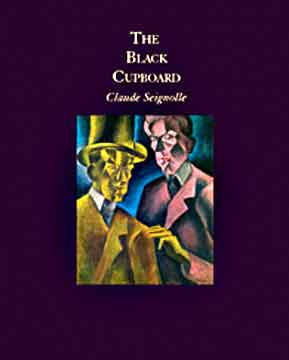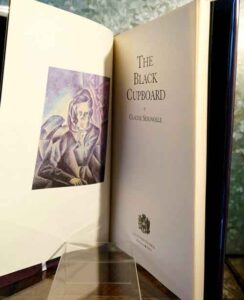By CLAUDE SEIGNOLLE (Ex Occidente Press; 1958/2010)
Only 100 copies were printed of this hardcover novella, the first-ever English version of a key work by France’s brilliant Claude Seignolle, and they weren’t cheap. Say what you will about Ex Occidente’s publishing strategy, but I truly believe THE BLACK CUPBOARD to be a masterpiece of surreal horror, and one of the most fascinating and confounding such publications of the 20th Century.
Claude Seignolle is known primarily for his folklore inspired tales of horror set in the French countryside, as found in his previous English language publications THE ACCURSED and THE NIGHTCHARMER. THE BLACK CUPBOARD seems an anomaly in the Seignolle cannon, with its urban setting and gleefully convoluted, science fiction tinged narrative that’s quite redolent of the work of Belgium’s Jean Ray (whose novel MALPERTUIS and novella “The Tenebrous Alley” have much in common with the present book). Yet, as the translator Antonio Monteiro’s learned introduction makes clear, the tale contains all of Seignolle’s trademarks: the blunt acceptance of supernatural phenomena as an integral part of everyday life, the frank (for 1958) approach to sexuality, and the classic, even prehistoric, themes that power the narrative.
Although it’s an extremely short work (it runs a little over sixty pages) THE BLACK CUPBOARD is as rich and eventful as nearly any horror story I’ve read, juxtaposing reincarnation, a Faustian pact and a doppelganger drama straight out of DR. JEKYLL AND MR. HYDE (which Seignolle is said to have admired tremendously). What unites it all is the overriding theme of the inevitability of fate and the powerlessness of Seignolle’s protagonists to alter their collective destiny—which, as is made clear early on, happens to be a mighty bleak one.
The tale is related in the form of recollections by 20-year-old Philippe, who one evening finds himself drawn, with an urgency he can’t explain, to purchase an old cupboard from an antique shop. Once the cupboard is ensconced in his house Philippe feels the “disturbing invisible presence” of another person, and actually comes to assume the guise of another man, a nasty old letch with an identical cupboard in his house. The manner in which Seignolle alternates the two first person viewpoints, with little demarcation of any sort, is the book’s most audacious stylistic element.
The old man, it seems, has sold his soul to the devil in exchange for unlimited sexual virility. He demonstrates this in a delirious orgy with four whores, but finds his depraved desires increasingly focused on a woman whose photo adorns his cupboard. That woman happens to be Philippe’s girlfriend, who Philippe, having experienced the old man’s desires in the flesh, becomes determined to protect. But can he outwit a cruel destiny? As Philippe bewails toward the conclusion of his account, “I am now sure that a horrible irresistible ending is swiftly approaching.”
With its elemental themes, THE BLACK CUPBOARD is in many respects a traditional account of good and evil, yet what ultimately resonates is the overpowering air of surreal mystery. I haven’t even gone into the mysterious “other” who shadows Philippe, nor the rag-like mask found in the cupboard’s drawers, nor the perverse episode in which Philippe, overcome with despair over his fate, interacts with his cupboard in a climactic sexually-tinged communion: “I turn off the radio and the lights…Now, in the dark, the cupboard and I have at last found again our intimacy…”


